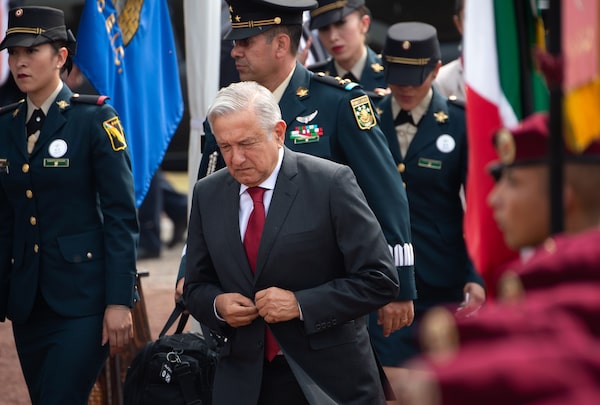
Mexican President Andres Manuel Lopez Obrador, seen here attending the official event to mark the beginning of the construction of a new international airport, pledged to take steps to protect the press. But after only weeks in office, his relationship with the media began to deteriorate, and it is now openly antagonistic.PEDRO PARDO/AFP/Getty Images
Juan Pardinas is one of the most powerful and respected journalists in Mexico, but that’s not enough to insulate him from death threats. Mr. Pardinas, the editor-in-chief of Mexico City newspaper Reforma, is the new face of journalism under siege in the country after he angered President Andres Manuel Lopez Obrador.
The centrist Reforma regularly covers the major government contracts awarded to cronies of AMLO (as the president is commonly known) and the cost to the public purse of presidential decisions such as the cancellation of a half-built international airport in the capital. When the President went after Mr. Pardinas by name last week – after repeatedly heaping scorn on Reforma’s coverage in general as fake news that panders to conservatives – the editor-in-chief found himself the direct target of threats. (Mr. Pardinas and the authorities have not commented on the source of threats because an investigation is still in progress.)
“It’s very paradoxical that now the state is offering protection for my security from an environment of hate that was promoted and harvested by the head of state,” Mr. Pardinas said in an interview. “And I think the President is also losing perspective on the consequences [his words] have. ... We live in one of the most dangerous places to do journalism in the world – that is not a responsibility of President Lopez Obrador, that situation has been brewing for decades, one of several dimensions of impunity and weak rule of law – but this is the context."
Mexico is the second-most dangerous country for journalists. (Four Mexican journalists have been slain since the President took office on Dec. 1., according to press freedom organization Article 19, while the killings of another two people may have been motivated by their journalism, but those cases are not yet confirmed). During his election campaign last year, Mr. Lopez Obrador pledged to take steps to protect the press, but after only weeks in office, his relationship with the media began to deteriorate, and it is now openly antagonistic.
Mr. Pardinas said that with his profile, he has a degree of protection that journalists working in the profoundly violent states such as Veracruz and Guerrero do not. “But there you have municipal governors mimicking the President’s approach to the press, saying, ‘There is a good press and a bad press’ – what does this mean for the lives of journalists?”
Journalist killings in Mexico have a rate of impunity – that is, no one is held accountable or punished – of more than 95 per cent, and these cases are on track to be no different. Rafael Murua Manriquez, for example, a radio reporter in the state of Baja California Sur, was receiving protection from the government program and had repeatedly received death threats from a powerful politician in his area, but after he was shot and killed on Jan. 20, police insisted he had an accidental run-in with narcotraffickers.
Mr. Pardinas is not new to the role of government target – the previous administration of Enrique Pena Nieto used Israeli spyware to monitor his activities, as it did a number of other prominent journalists – but he said the growing power of social media in Mexico has changed the nature of the attacks, exponentially increasing their volume and level of hostility. “[Reporters] ask uncomfortable but totally difficult questions at the president’s press conferences every morning and then what happens:" those reporters immediately are deluged with animosity and threats from AMLO supporters, he said. (Mr. Lopez Obrador began an ostensibly more transparent regime by instituting a daily 7 a.m. open press conference; his predecessor did fewer open press encounters in a six-year term than the new President did in his first month).
Reforma may be a particular bugbear for the President because it is less vulnerable to a tool that Mexican governments have traditionally used to guarantee themselves sympathetic coverage – a massive advertising spend that made up a significant part of the budget of many media corporations. Mr. Lopez Obrador has dramatically reduced that spending, but Reforma was less reliant on it than other publications, which are commonly believed to be tempering their criticisms in order to ensure that the limited money available still flows their way.
“Independent journalism does not align with a grandiloquent narrative that neoliberalism is over in Mexico, that corruption is over – when you put a pin in the big balloon of this narrative, the president doesn’t like it,” Mr. Pardinas said.
Advocacy organization Propuesta Civica, which supports the families of murdered Mexican journalists in their search for justice, launched a campaign this week with first-person Twitter accounts in the names of four slain reporters, tweeting on the stories they were killed covering. “It’s very important to keep these reporters at front of mind,” said Mauricio Perez Munoz, spokesperson for the group. “We see this detachment in Mexican society with regard to journalists – historically there is a misunderstanding of the press, and every time a journalist is murdered you notice how society disengages. ... These crimes against journalists become statistics.”